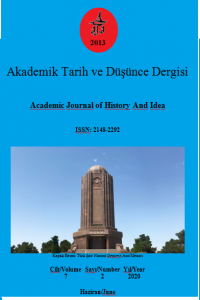Tarixiy-qomusiy manbalarda ifodalangan olamning lisoniy manzarasi va uning madaniyat tarixini o’rganishdagi o’rni (Mahmud Koshg’ariyning “Devonu lug’at-it turk” asari misolida)
Ushbu maqolada til, uning madaniy-tarixiy areallari, tarixiy taraqqiyoti jarayonlari aks etgan tarixiy-qomusiy asarlar, jumladan Mahmud Koshg’ariyning“Devonu lug’at-it turk” asari misolida tahlil etiladi. Ma’lum bir tilning tarixiy kategoriya ekanliği, shu tufayli til va u amal qilgan davr bir-biri bilan sinxronik, panaxronik va statik tizim sifatidagi bog’liqlikligi qayd etilgan. Turkiy va o‘zbek tillarining madaniy–tarixiy areallari, unda turli davrlarda qo’llangan so’z va tushunchalarva izohlari tarixiy – qomusiy lug‘atlar va yozma manbalarga asosan tahlil etilgan.Til taraqqiyotining turli bosqichlaridagi shakliy va ma’noviy o‘zgarishhaqida ayrim mulohazalar keltirilgan hamda misollar bilan dalillangan.Mahmud Koshg’ariyning “Devonu lug’at-it turk” asari kabi tarixiy-qomusiy asarlarning va ularda ifodalangan dunyoning lisoniy manzarasining tarixiy, madaniy va ilmiy qiymati ko’rsatib berilgan.
Anahtar Kelimeler:
Mahmud Koshg’ariy, “Devonu lug’at-it turk”
The Language picture of the World represented in historical and encyclopedic sources and its place in the study of cultural history (In the example of ân Mahmut Kashgary's “Divânü Lugât’it-Türk”)
In this article, the place of historical and encyclopedic works reflecting cultural and historical areals of language and its historical development processes are examined in the example of Mahmut Kashgary's''Divânü Lugât’it-Türk'' . It is stated that a certain language is a historical category and therefore the language and the historical period in which it develops are connected as synchronic, panacronic and static systems. The cultural and historical spheres of the various branches of Turkic, also Uzbek language, the meaning and interpretation of the words and concepts used in different periods in Turkic are analyzed based on historical - encyclopedic dictionaries and written sources. Some explanations are given about the examples of words that have undergone changes in different stages of language history and the evolutionary changes taking place in them.The historical, cultural and scientific value of the linguistic landscape of the world is given in historical and encyclopedic sources such an as “Divânü Lugât’it-Türk” by Mahmut Kashgary.
Keywords:
Mahmut Kashgary, “Divânü Lugât’it-Türk”,
___
- DUDCHIK A. S., SIMONOVA A. A., SHNOTINA A. A. Yazik i vremya: problema smisla v filosofii i yazike // Nauchno-metodicheskiy elektronniy jurnal «Konsept». – 2016. – T. 2. – 576–580.
- IVANOV V. B. Myortvie yaziki // Lingvisticheskiy ensiklopedicheskiy slovar/ Gl. red. V. N. Yarseva. -M.: Sovetskaya ensiklopediya, 1990. — 683.
- KOLLEKTIV. Drevnetyurkskiy slovar –L: Nauka, Leningradskoe otdelenie, 1969.
- KOLLEKTIV. Etimologicheskiy slovar tyurkskiх yazikov. T.1-3. -M.: Vostochnayaliteratura, 1974-1980 - 768 + 349 + 395.
- LABOV, UİLYAM. O meхanizme yazikoviх izmeneniy // Novoe v lingvistike. Vip.7. Sotsiolingvistika, M: Progress, 1975.
- LOMTEV T.P. K voprosu o prichinno-sledstvenniх otnosheniyaх
- Yayın Aralığı: Yılda 6 Sayı
- Başlangıç: 2013
- Yayıncı: Hakan YILMAZ
Sayıdaki Diğer Makaleler
Azerbaycan’a Yönelik Ermeni Terörizmi
Transkafkasya'da (Güney Kafkasya) Devletlerarası İlişkiler ve Mülteci Sorunları (1918-1920)
IV. Murat’ın Revan Seferi’nde Bir Lojistik Destek Merkezi: Bayburt
Erzurum’da Önemli Bir Tunç Çağı Merkezi: Aşkale Höyük
Ortadoğu Ülkelerinin Anayasalarında Parlamenter Muafiyetler
Nova Berde Gümüş Madenleri (1453-1600)
